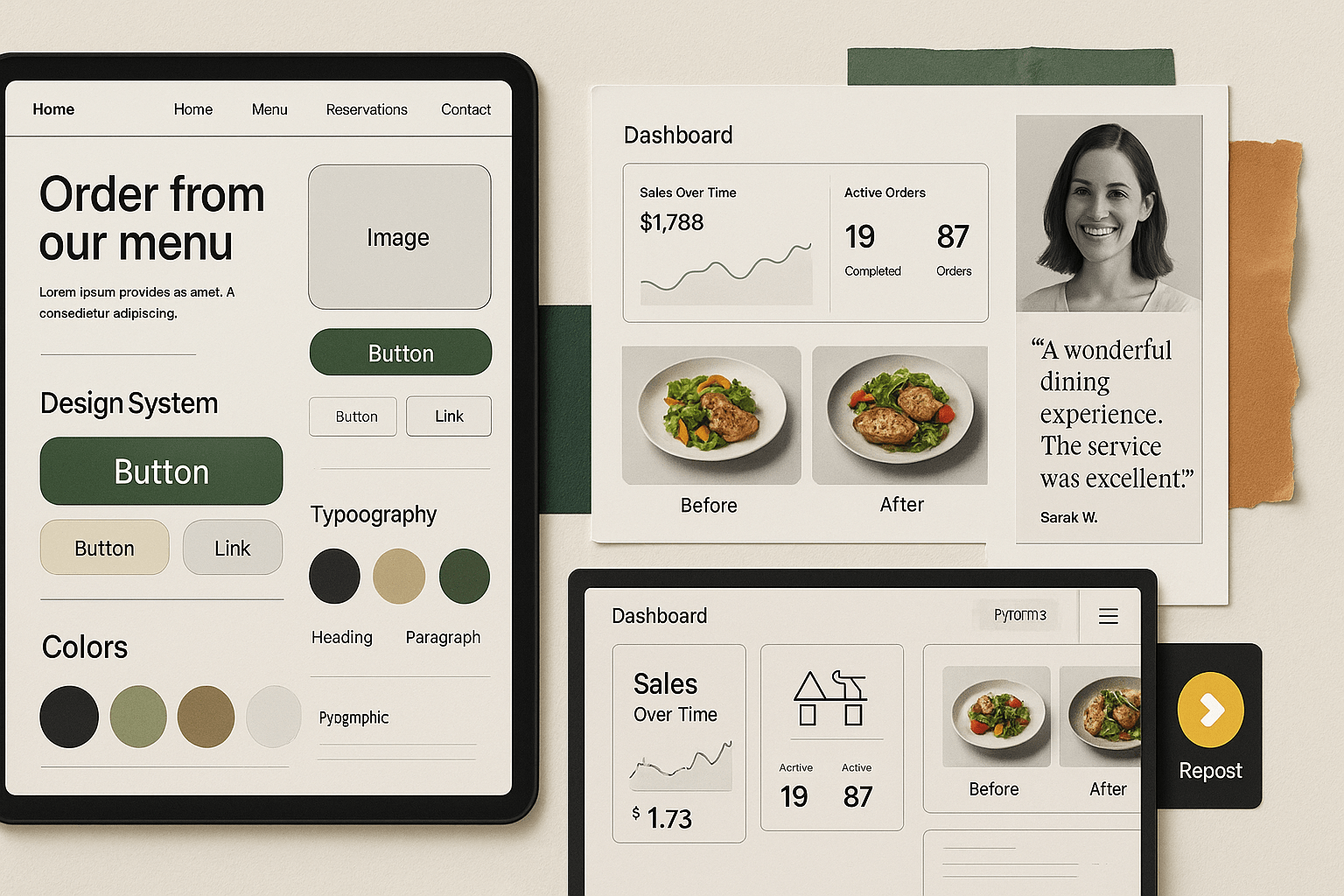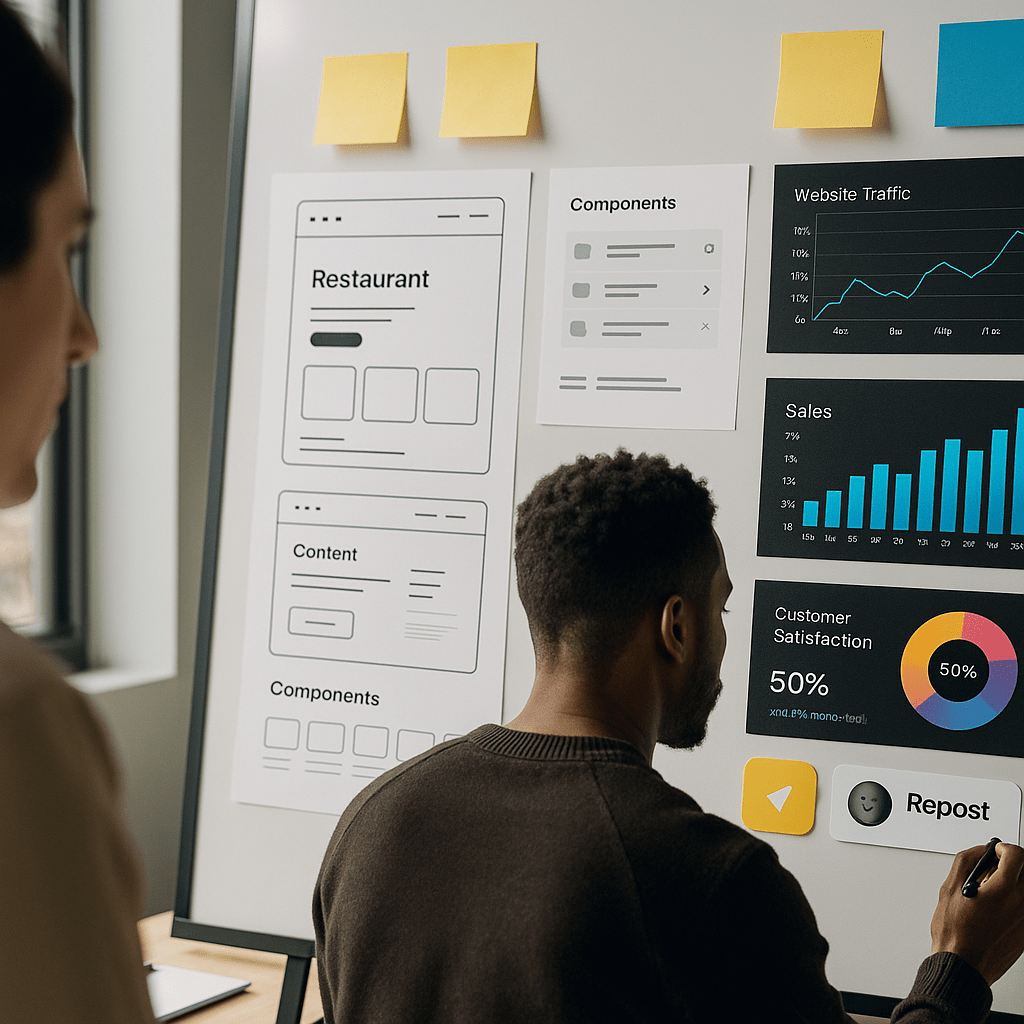Why Restaurants Use UI/UX Design
by Design Delulu Editorial · September 21, 2025

In today's digital-first world, restaurants face unprecedented challenges in attracting and retaining customers. While exceptional food and service remain fundamental, the digital experience your restaurant provides can make or break your business success. This is where UI/UX design becomes not just beneficial, but essential for modern restaurants looking to thrive in a competitive market.

Why Restaurants Need UI/UX Design
Key Challenges Restaurants Face
Modern restaurants encounter several critical digital challenges that directly impact their bottom line:
- Customer Experience Fragmentation: Today's diners interact with restaurants across multiple touchpoints - websites, mobile apps, online ordering platforms, social media, and reservation systems. Without cohesive UI/UX design, these interactions can feel disjointed and frustrating, leading to abandoned orders and lost customers.
- Mobile-First Expectations: With over 60% of restaurant searches happening on mobile devices, restaurants need interfaces that work flawlessly on smartphones and tablets. Poor mobile experiences translate directly to lost revenue, as customers quickly abandon sites that don't load properly or are difficult to navigate.
- Complex Ordering Processes: Traditional online ordering systems often suffer from overcomplicated checkout processes, unclear menu presentations, and confusing navigation. These friction points cause customers to abandon their orders, sometimes switching to competitors with smoother experiences.
- Brand Differentiation Struggles: In a saturated market, restaurants struggle to communicate their unique value proposition effectively through their digital presence, making it harder to stand out from countless competitors.
How UI/UX Design Solves These Problems
Strategic UI/UX design addresses these challenges through proven methodologies:
- Unified Experience Design: Professional UI/UX design creates consistent visual language and interaction patterns across all digital touchpoints, ensuring customers have a cohesive brand experience whether they're browsing your website, using your app, or engaging on social media.
- Mobile-Optimized Interfaces: Expert designers prioritize mobile-first approaches, creating responsive designs that adapt seamlessly to any device size while maintaining functionality and visual appeal.
- Streamlined User Journeys: Through user research and testing, UI/UX designers identify and eliminate friction points in the ordering process, creating intuitive paths that guide customers from menu browsing to completed orders.
- Strategic Brand Expression: Design professionals help restaurants communicate their unique personality and value through carefully crafted visual elements, typography, and interactive features that resonate with target audiences.

Essential Features of UI/UX Design for Restaurants
Must-Have Design Elements and Workflows
Intuitive Menu Navigation: Effective restaurant UI/UX design organizes menu items logically, uses clear categorization, and implements smart search functionality. Visual hierarchy guides customers' attention to featured items and promotions while making it easy to find specific dishes or dietary options.
Seamless Ordering Flow
The best restaurant interfaces minimize the steps between menu selection and order completion. This includes features like quick reorder options, saved payment methods, order customization tools, and clear progress indicators throughout the checkout process.
Visual Appetite Appeal
High-quality food photography, consistent styling, and strategic use of color psychology help stimulate appetite and encourage larger orders. Professional UI/UX design ensures these visual elements load quickly and display beautifully across all devices.
Location and Hours Integration
Smart design incorporates dynamic location information, real-time hours updates, and integrated mapping functionality to help customers find and visit your restaurant easily.
Real-World Examples
Domino's Pizza Tracker: This innovative UI feature transformed the pizza ordering experience by providing real-time order status updates, reducing customer anxiety and support calls while building excitement for delivery.
Starbucks Mobile App: The app's UI seamlessly integrates loyalty programs, mobile ordering, and store location features, creating a unified experience that drives both online and in-store purchases.
Local Success Stories: Many independent restaurants have seen significant improvements by implementing clean, mobile-friendly designs with simplified ordering processes, resulting in increased online orders and improved customer satisfaction scores.

Common Mistakes to Avoid
Typical Pitfalls in UI/UX Design for Restaurants
Overwhelming Menu Presentations: Many restaurants make the mistake of trying to display their entire menu on a single screen, creating cognitive overload that paralyzes decision-making. Customers faced with too many choices often abandon their orders entirely.
Neglecting Load Speed Optimization: Restaurant websites often suffer from slow-loading high-resolution images and unoptimized code. Every second of delay can result in significant conversion losses, particularly on mobile devices with slower connections.
Ignoring Accessibility Standards: Failing to consider users with disabilities not only limits your potential customer base but can also create legal compliance issues. Poor color contrast, missing alt text, and non-keyboard-friendly navigation are common oversights.
Complex Registration Requirements: Forcing customers to create accounts before ordering creates unnecessary friction that drives potential customers away, especially for first-time visitors who just want to place a quick order.
How to Do Better
Progressive Disclosure: Present menu information gradually, starting with categories and drilling down to details only when requested. This approach reduces cognitive load while still providing comprehensive information.
Performance Optimization: Implement image compression, lazy loading, and efficient caching strategies to ensure fast load times across all devices and connection speeds.
Universal Design Principles: Follow WCAG guidelines to create interfaces that work for users with varying abilities, including proper color contrast, keyboard navigation support, and screen reader compatibility.
Guest Checkout Options: Always provide the option to order without creating an account, while still offering account creation as a value-added convenience for those who want it.
SEO / Growth Best Practices
Optimization Tips Specific to Restaurants
Local SEO Integration: UI/UX design should incorporate local schema markup, consistent NAP (Name, Address, Phone) information, and location-specific content to improve local search rankings. This includes designing location pages that provide value beyond basic contact information.
Content-Rich Menu Pages: Transform simple menu listings into content-rich pages with detailed descriptions, ingredient information, and customer reviews. This approach provides more indexable content for search engines while helping customers make informed decisions.
Social Media Integration: Design interfaces that make it easy for customers to share their experiences, orders, and favorite menu items across social platforms, generating valuable user-generated content and social signals.
Review and Testimonial Showcase: Incorporate customer reviews and ratings directly into your UI design, as this content provides fresh, relevant text for search engines while building trust with potential customers.
Leveraging UI/UX Design for Visibility and Results
Conversion Rate Optimization: Use A/B testing within your UI/UX framework to continuously improve conversion rates. Test different call-to-action buttons, menu layouts, and checkout processes to identify what drives the most orders.
Analytics Integration: Design interfaces that make it easy to track user behavior, popular menu items, and conversion funnels. This data informs both design improvements and business decisions.
Email Capture Strategies: Implement non-intrusive email capture mechanisms within your UI, such as offering first-time visitor discounts or loyalty program enrollment, to build your marketing database.
Cross-Platform Consistency: Ensure your brand experience remains consistent across your website, mobile app, third-party delivery platforms, and social media presence to reinforce brand recognition and trust.
The investment in professional UI/UX design pays dividends through increased online orders, improved customer satisfaction, and stronger brand loyalty. Restaurants that prioritize user experience create competitive advantages that extend far beyond their digital presence, influencing overall business success.
👉 Ready to improve your restaurant with professional UI/UX design? Explore Design Delulu’s UI/UX Design services to discover how strategic design can transform your restaurant's digital presence and drive measurable business results.